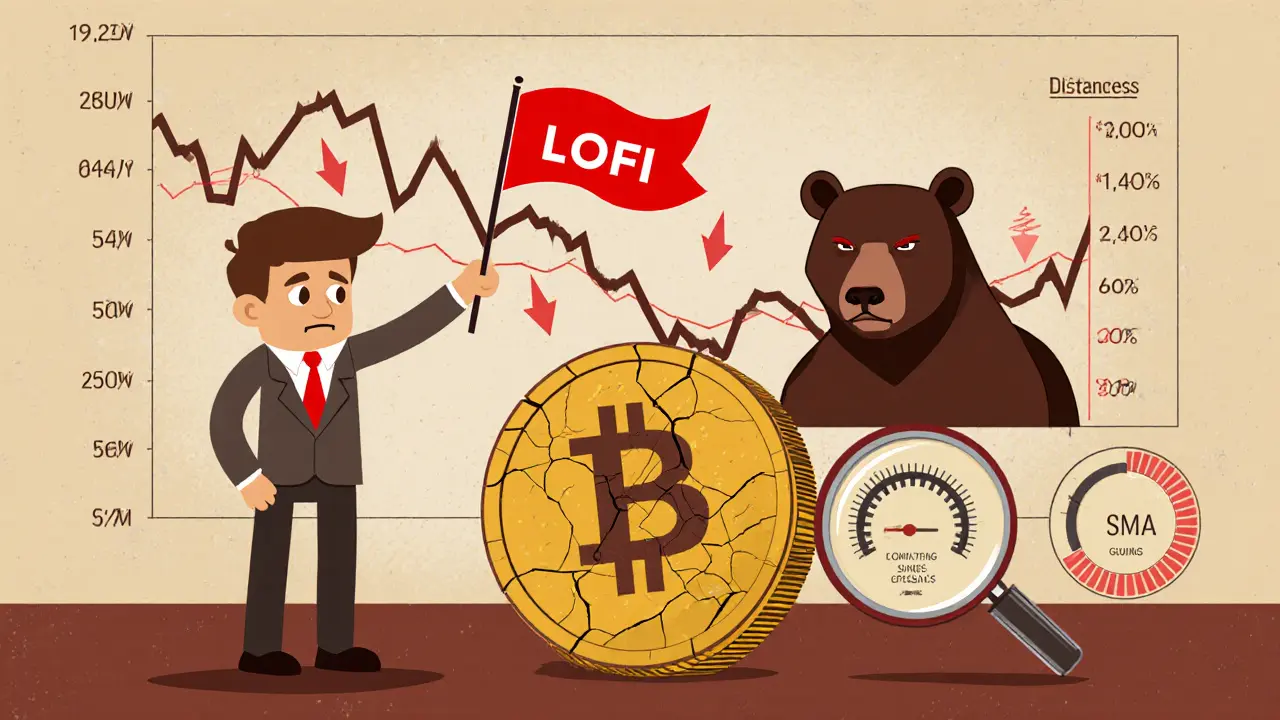LOFI Token Value Estimator
Investment Calculator
Estimated Value
Current Value
LOFI tokens at $0.01693
Potential Value
At $0.0119 (25% drop)
= USD
High Risk Warning
LOFI is a highly volatile cryptocurrency. Price data varies across platforms, and the project has significant risks including blockchain ambiguity, inconsistent data, and regulatory uncertainty. This tool is for informational purposes only and does not constitute investment advice.
When talking about LOFI (LOFI) is a cryptocurrency token that markets itself as a decentralized finance (DeFi) "watch‑to‑earn" project, the first thing most people wonder is whether it’s a serious financial tool or just another meme‑coin hype cycle. In this guide we unpack the token’s backstory, technical claims, tokenomics, market figures, and the biggest red flags that investors should watch for.
Overview - What LOFI Claims to Be
LOFI positions itself as a bridge between the booming creator economy and DeFi incentives. The branding revolves around a mythical “snow monster” that was “frozen in time” in the Himalayas and now awakens to challenge "tribalism and chaos" in finance. The narrative is deliberately whimsical, aiming to attract "builders, believers and dreamers" who want to earn while watching online content.
The core promise is a Watch‑to‑Earn model: users stream videos, music, or live streams and receive LOFI tokens as a reward for time spent watching. The token also functions as a governance token, letting holders vote on protocol upgrades and ecosystem decisions.
Technical Foundations - Which Blockchain Is LOFI On?
One of the most confusing aspects is the blockchain claim. Gate.com lists LOFI as built on the Sui blockchain, while CoinSwitch reports a Solana blockchain deployment. Both platforms are high‑throughput, low‑fee ecosystems, but the discrepancy suggests either a migration, a dual‑chain launch, or simply reporting errors.
Developers familiar with Solana’s Rust‑based contracts and Sui’s Move language should note that cross‑chain compatibility would require a bridging solution-something the project’s documentation does not yet detail. Until the official code repo clarifies the exact runtime, potential users should treat the technical claim as provisional.
Tokenomics - Supply, Allocation, and Early Sales
According to CryptoRank, LOFI has a total supply of 10 billion tokens. The allocation breakdown is as follows:
- 18 % (1.8 bn) reserved for private/pre‑sale investors.
- 0.15 % (15 m) offered in the public IDO.
- Remaining tokens allocated to ecosystem incentives, liquidity, and team vesting (exact percentages not publicly disclosed).
The Initial DEX Offering (IDO) ran from September 1‑3 2022, raising $75,000 at $0.005 per token. An earlier seed round collected $450,000 at $0.0015 per token for 300 million tokens, delivering an early‑investor ROI of nearly 30×.
Current circulating supply figures differ across trackers. CoinGecko reports roughly 1 billion tokens in circulation, while other sites list higher numbers, reinforcing the need for on‑chain verification.

Market Performance - Price, Volume, and Sentiment
Price data is wildly inconsistent. CoinMarketCap shows LOFI at $0.01693 with a 24‑hour volume of $3.9 million, whereas CoinGecko lists $0.01643 and a similar volume, and yet another feed reports $0.63374 with a sharp decline.
Technical indicators from CoinCodex paint a bearish picture: 14‑day RSI at 39.79 (near oversold), 50‑day SMA $0.02076 and 200‑day SMA $0.02984, both above the current price, indicating downward pressure. The Fear & Greed Index sits at 33 (Fear), and volatility is about 13.5 %.
Price forecasts are equally gloomy. CoinCodex predicts a 25 % drop to $0.0119 by the end of October 2025, with a potential high of $0.0295 in March 2025 before another decline.
How the Watch‑to‑Earn Model Supposedly Works
In theory, a user links a crypto wallet to the LOFI platform, selects a streaming partner (e.g., a video creator), and starts watching. The protocol tracks minutes watched and issues a fixed number of tokens per hour. However, the whitepaper does not disclose the exact conversion rate, nor does it explain whether the reward pool is funded by advertising revenue, token inflation, or a combination of both.
Without transparent on‑chain accounting, it’s difficult to verify that rewards are genuinely earned rather than minted out of thin air. This opacity is a common criticism of many X‑to‑Earn projects, where the tokenomics often rely on continuous inflow of new participants.
Risks & Criticisms
Investors should keep several red flags in mind:
- Blockchain ambiguity: Conflicting reports on whether LOFI runs on Sui or Solana hinder confidence in its technical stability.
- Data inconsistency: Price, volume, and supply numbers vary dramatically across tracking sites, suggesting either multiple tokens sharing the LOFI ticker or poor data aggregation.
- Limited adoption: No significant community presence on Reddit, Discord, or Twitter makes it hard to gauge real user interest.
- Regulatory exposure: Earning tokens for content consumption could fall under securities or gambling regulations in several jurisdictions.
- Bearish technical outlook: RSI below 40, SMA above price, and low green-day ratio all point to a downward trend.
While early investors saw massive upside, the token’s price has since corrected sharply. Anyone considering a purchase should treat it as high‑risk speculative exposure.

Comparison with Other X‑to‑Earn Tokens
Below is a quick snapshot of how LOFI stacks up against two better‑known “earn‑while‑you‑play” projects.
| Metric | LOFI (LOFI) | StepN (GMT) | Axie Infinity (AXS) |
|---|---|---|---|
| Primary Earn Model | Watch‑to‑Earn | Move‑to‑Earn | Play‑to‑Earn |
| Underlying Blockchain | Sui / Solana (unclear) | Solana | Ethereum |
| Total Supply | 10 B | 10 B | 360 M |
| Market Cap (approx.) | $0.5 M | $800 M | $1.2 B |
| Active Users (30‑day) | ~5 k (estimated) | ~1 M | ~500 k |
| Community Sentiment | Bearish | Mixed | Mixed‑to‑Bullish |
From the table it’s clear that LOFI lags far behind its peers in adoption, market cap, and community confidence. The unique watch‑to‑earn angle could be a differentiator, but it remains unproven.
What to Watch Going Forward
If LOFI wants to survive the next six months, it should prioritize:
- Publishing a verifiable smart‑contract address on the claimed blockchain.
- Releasing transparent on‑chain analytics for reward distribution.
- Building a lively community hub where users can share earnings screenshots.
- Clarifying regulatory compliance for reward‑based streaming.
Without these steps, the token will likely remain a niche speculation with limited upside.
Quick Takeaways
- LOFI is a LOFI crypto token marketed as a watch‑to‑earn DeFi project.
- Technical foundation is ambiguous: sources cite both Sui and Solana.
- Tokenomics feature a 10 B supply, heavy early‑investor allocation, and a modest public IDO.
- Price data is inconsistent; technical indicators are bearish.
- Community and documentation are thin, making the project high‑risk.
Is LOFI built on Solana or Sui?
Public sources disagree - Gate.com lists Sui, while CoinSwitch lists Solana. The project has not published a definitive contract address, so investors should treat the blockchain claim as unverified until official confirmation.
How does the watch‑to‑earn mechanism reward users?
Users connect a crypto wallet, watch partnered content, and earn a set amount of LOFI tokens per minute. The exact token‑per‑minute rate and funding source are not disclosed in the whitepaper.
What is the current market price of LOFI?
Price feeds differ, but major aggregators list LOFI around $0.016-$0.017 USD, with daily volume near $4 million. Prices can swing rapidly due to low liquidity.
Is LOFI a good long‑term investment?
Given the unclear blockchain, scarce community, bearish technical indicators, and regulatory uncertainty, LOFI should be considered a high‑risk speculative asset rather than a stable long‑term hold.
Where can I find official LOFI documentation?
The project’s official website provides a brief overview but lacks detailed technical docs or verified contract links. Investors often have to rely on third‑party aggregators, which may contain outdated or inaccurate information.


Jenna Em
October 21, 2025 AT 09:42Ever wonder who's really pulling the strings behind LOFI? It feels like another piece in the puzzle of shadowy groups trying to steer us into digital serfs. They smile, they call it "watch‑to‑earn", but the real profit goes elsewhere.
Stephen Rees
October 21, 2025 AT 12:29It’s almost as if the narrative itself is a veil, quietly masking the true purpose while promising simple rewards. One could argue the silence is louder than any marketing hype.
Katheline Coleman
October 21, 2025 AT 15:15In accordance with the data presented, the tokenomics of LOFI exhibit a disproportionate allocation toward early investors, which raises legitimate concerns regarding equitable distribution. A thorough audit, preferably on‑chain, would provide the requisite transparency for potential stakeholders.
Amy Kember
October 21, 2025 AT 18:02Exactly - without a verifiable contract address, the numbers remain speculative at best.
Evan Holmes
October 21, 2025 AT 20:49Looks like another meme‑coin to me.
Isabelle Filion
October 21, 2025 AT 23:35Ah, LOFI – the latest darling of the crypto avant‑garde, draped in a frosty mascot and a promise that watching cat videos will line your digital pockets. One must first applaud the ingenuity of marketing a financial instrument as a passive leisure activity. Yet when the underlying blockchain is as ambiguous as a politician’s promise, skepticism is not merely advisable, it is mandatory. The purported dual‑chain deployment on both Sui and Solana reads less like a technical feat and more like a desperate attempt to hedge against due diligence. Investors are presented with a token supply of ten billion, a figure that, while mathematically sound, is practically limitless in its inflationary potential. Early private sales accounted for eighteen percent of that supply, effectively handing a privileged few a monopoly on any future upside. The public IDO, with its meager fifteen‑million‑token offering, seems designed to create an illusion of accessibility while preserving the status quo. Price feeds oscillate wildly, a symptom not of healthy market dynamics but of thin liquidity and fragmented data sources. Technical indicators, such as an RSI hovering below forty, signal oversold conditions, yet they also hint at a lack of buying pressure. Moreover, the absence of a transparent reward‑distribution mechanism renders the watch‑to‑earn model opaque at best. If the token emissions are funded by advertising revenue, one would expect a clear flow of funds, but the whitepaper conveniently omits this detail. Should inflation be the source, the token’s long‑term value is destined for a slow erosion. Regulatory considerations compound these issues; compensating users for content consumption may well venture into securities territory. Community metrics further betray a project in search of relevance – fewer than five thousand active users is a whisper in the cacophony of crypto discourse. In short, LOFI embodies the archetype of a speculative venture masquerading as an innovative utility. Prospective participants would be well advised to treat it as a high‑risk experiment rather than a cornerstone of a diversified portfolio.